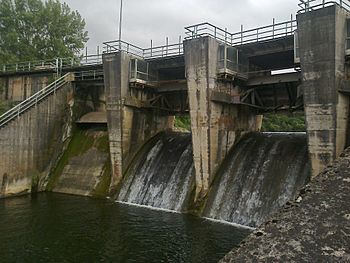Aboño facts for kids
The Aboño River is a small but important river located in northern Spain. It flows through the beautiful region of Asturias, a part of Spain known for its green landscapes and rugged coastline. The river eventually empties into the Bay of Biscay, which is part of the Atlantic Ocean.
Quick facts for kids Aboño |
|
|---|---|

Dam of San Andrés de los Tacones
|
|
| Other name(s) | Aboñu |
| Country | Spain |
| State | Asturias |
| Region | Carreño; Llanera |
| Physical characteristics | |
| Main source | 43°27′7″N 5°43′5″W / 43.45194°N 5.71806°W |
| River mouth | Bay of Biscay 43°34′7″N 5°42′42″W / 43.56861°N 5.71167°W |
| Length | 9.7 km (6.0 mi) |
Contents
Where Does the Aboño River Flow?
The Aboño River is located in the northern part of Spain. It flows entirely within the Autonomous Community of Asturias. This region is known for its green mountains and beautiful coastlines.
River's Journey
The river starts its journey in the municipality of Llanera. From there, it makes its way through the landscape. It passes through the area of Carreño before reaching the sea.
Length of the River
The Aboño River is not very long. It stretches for about 9.7 kilometers (about 6 miles). This makes it a relatively short river compared to many others in Spain.
Where Does the Aboño River End?
The Aboño River eventually flows into the Bay of Biscay. This bay is a large inlet of the Atlantic Ocean. It is located along the western coast of France and the northern coast of Spain.
Meeting the Sea
The point where the river meets the sea is called its mouth. For the Aboño River, its mouth is in the Bay of Biscay. This is where the river's fresh water mixes with the salty ocean water.
Why Are Rivers Important?
Rivers like the Aboño are very important for many reasons. They provide water for plants and animals. They also support different kinds of ecosystems.
Nature and Wildlife
Rivers create habitats for fish, birds, and other wildlife. The areas around rivers are often rich in plant life. This makes them important places for biodiversity.
Human Use
Historically, rivers have been important for people too. They were used for travel and trade. Today, rivers can still be used for fishing or simply enjoying nature.
See also
 In Spanish: Río Aboño para niños
In Spanish: Río Aboño para niños

